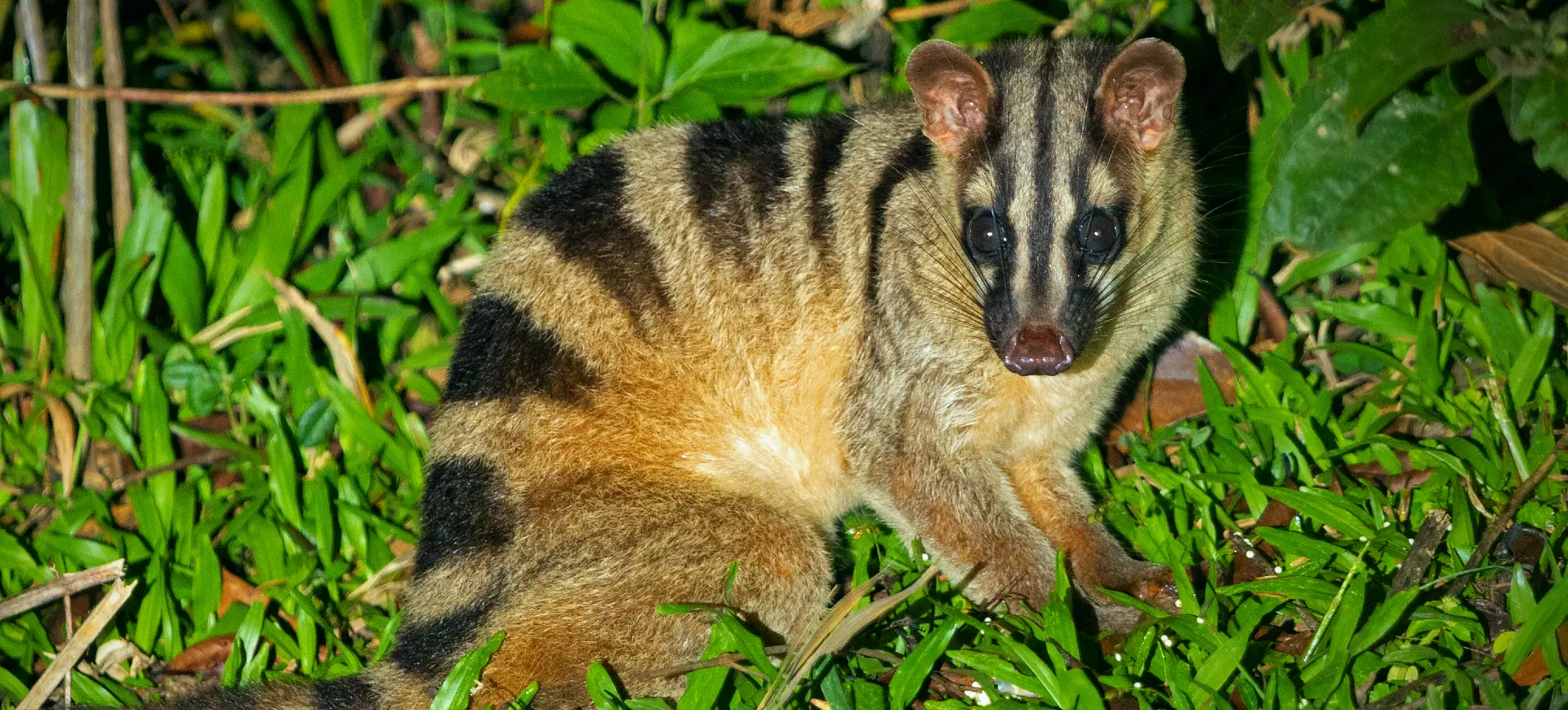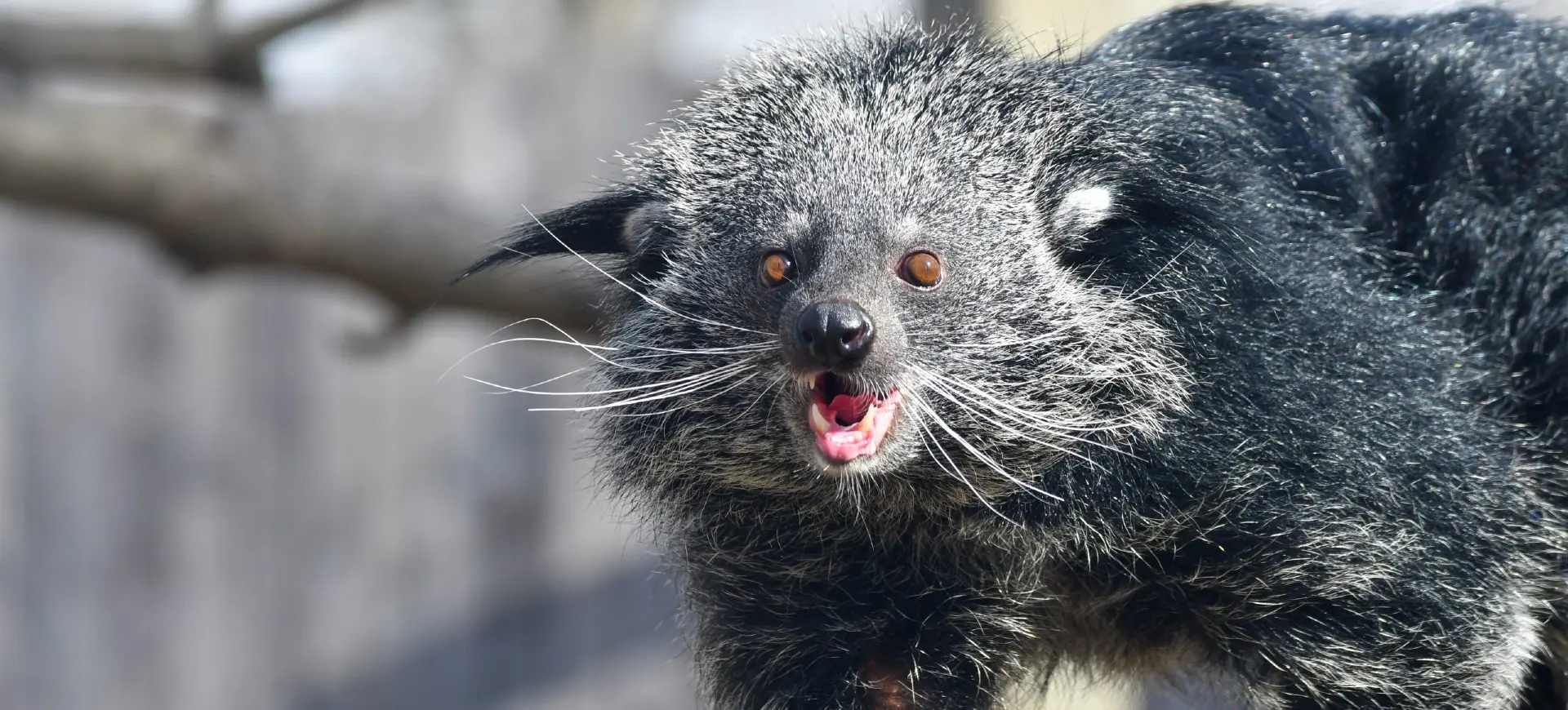Overview
The Large-spotted Genet, scientifically known as Genetta tigrina, is a small, cat-like mammal native to Africa. Characterized by its long body, short legs, and long, bushy tail, it is easily identified by its distinctive coat pattern. The fur is pale grey or yellowish, adorned with large, dark spots and stripes, providing excellent camouflage in its natural habitat. Its retractable claws and flexible body make it an agile climber, adept at navigating through trees and dense vegetation.
Primarily nocturnal, the Large-spotted Genet is a solitary and elusive creature, spending its days hidden in dense vegetation or hollows. Its varied diet, including small mammals, birds, insects, and fruit, showcases its adaptability as a forager. The species is known for its incredible agility and ability to move silently through its environment, which aids in hunting and avoiding predators.
The Large-spotted Genet plays a significant role in its ecosystem as a predator and seed disperser. As a carnivore, it helps control populations of rodents and insects, while its consumption of fruit contributes to seed dispersal. This species is a fascinating example of the adaptability and diversity of small carnivores in African ecosystems.
Taxonomy
Kingdom
Phylum
Class
Order
Family
Genus
Species
Type
Physical Description:
The Large-spotted Genet is a slender and graceful animal with a body structure that blends features of both cats and weasels. It has a small head with large, rounded ears and bright, curious eyes. The fur is soft and dense, providing insulation and camouflage. The coat pattern, with its large black spots and stripes against a lighter background, is one of its most striking features.
Males and females are similar in size and appearance, with males slightly larger. The long, bushy tail, marked with rings, is almost as long as the body and aids in balance, especially when climbing. The genet’s paws are equipped with retractable claws, a feature that enhances its climbing skills. Its lithe and agile body allows for quick and stealthy movement on the ground and in trees.

Lifespan: Wild: ~10 years || Captivity: ~20 years

Weight: Male: 3.3-5.5 lbs (1.5-2.5 kg) || Female: 3.1-5.1 lbs (1.4-2.3 kg)

Length: Male: 34-42 inches (86-106 cm) || Female: 33-40 inches (84-101 cm)

Top Speed: 18 mph (29 km/h)
Characteristic:
Native Habitat:
The Large-spotted Genet is native to various habitats across southern Africa, demonstrating a notable adaptability to different environments. Its primary habitats include dense forests, where it can skillfully navigate through the canopy, and savannas, where it utilizes the cover of tall grasses and bushes. The species is also adept at living in scrublands and areas with rocky outcrops, taking advantage of the natural cover these landscapes provide. Their ability to thrive in diverse habitats highlights their ecological flexibility and skill in exploiting various environments for survival.
In addition to natural habitats, the Large-spotted Genet shows a remarkable ability to coexist in areas altered by human activity, often venturing close to rural and suburban settlements. They frequently seek refuge in tree hollows, dense undergrowth, or abandoned burrows, using these spaces for resting and as safe havens from predators. The presence of trees is crucial for their survival, as they are adept climbers and rely on arboreal routes for foraging and evasion. Their preference for areas with abundant food sources and secure hiding spots shapes their distribution across the varied landscapes of southern Africa.
Climate Zones:
Biomes:
Biogeographical Realms:
Continents:
Diet:
Diet & Feeding Habits:
The Large-spotted Genet is an opportunistic feeder with a diet that includes a variety of small animals and fruits. Its carnivorous tendencies lead it to hunt rodents, birds, and insects, using its stealth and agility to catch prey. It is particularly adept at hunting in trees capturing birds and tree-dwelling rodents.
In addition to animal prey, the genet also consumes fruit, a significant portion of its diet, especially in seasons when fruit is abundant. This omnivorous diet reflects the genet’s adaptability to different food sources available in its environment. Its role as a predator helps control populations of small animals, while its consumption of fruit aids in seed dispersal.
Mating Behavior:
Mating Description:
Large-spotted Genets are solitary animals, coming together only during the mating season. They do not have a fixed breeding season, but births peak during the warmer months. Males are polygynous, mating with multiple females in their territory. Courtship involves vocalizations, scent marking, and physical displays.
Females prepare a den in a secure location, such as a hollow tree or rocky crevice, where they give birth to one to three offspring after a gestation period of about 70-77 days. The young are born blind and dependent but develop quickly, becoming independent at around a year old. Parental care is primarily the mother’s responsibility, who nurses and protects the kits until they are self-sufficient.
Reproduction Season:
Birth Type:
Pregnancy Duration:
Female Name:
Male Name:
Baby Name:
Social Structure Description:
Large-spotted Genets are solitary and territorial animals, each maintaining a distinct territory that they mark with scent glands. They are primarily nocturnal, which helps reduce encounters with other genets and potential predators. While they are solitary, territories can overlap, and they may tolerate the presence of other genets at a distance.
Their social interactions are primarily limited to mating and mother-offspring relationships. Mothers are protective and nurturing, caring for their young until they are independent. Outside of breeding and rearing young, Large-spotted Genets have limited social structures and prefer a solitary lifestyle, which reduces competition for resources and helps them remain elusive.
Groups:
Conservation Status:
Population Trend:
The Large-spotted Genet is categorized as ‘Least Concern’ by the IUCN Red List, reflecting a stable population trend across its range. These genets are found in diverse habitats across southern Africa, demonstrating a remarkable ability to adapt to various environmental conditions. Despite their adaptability, accurate population assessments are difficult due to their elusive, nocturnal nature. They are quite common in certain regions, but their secretive behavior often keeps them hidden from human observation.
In some areas, the Large-spotted Genet faces challenges that could impact local populations, including habitat destruction and human-wildlife conflict. While overall numbers are considered stable, specific populations may experience a decline due to environmental pressures. Their resilience is evident in their widespread presence, but ongoing monitoring is essential to ensure their continued survival. Conservationists emphasize the importance of understanding and protecting these genets to maintain biodiversity within their ecosystems.
Population Threats:
Habitat loss and fragmentation are significant threats to the Large-spotted Genet, primarily driven by agricultural expansion, deforestation, and increasing urbanization. As their natural habitats shrink, these genets are forced into closer contact with human environments, leading to increased conflicts. They are sometimes persecuted as pests, especially in areas where they are known to prey on poultry or invade human dwellings in search of food. Additionally, road accidents and predation by domestic animals can significantly impact local populations.
Despite these challenges, the Large-spotted Genet’s adaptability has enabled it to survive in changing environments. However, human activities’ increasing intensity and scale threaten their well-being and habitat integrity. Conservationists are concerned that these pressures could lead to localized declines and long-term impacts on their population dynamics and genetic diversity without proper management and protection measures.
Conservation Efforts:
While the Large-spotted Genet is not endangered, conservation efforts are crucial to ensure its continued stability and prevent future decline. These efforts primarily focus on habitat conservation, protecting areas where genets and other wildlife thrive. Initiatives to preserve natural habitats, such as national parks and wildlife reserves, play a vital role in maintaining healthy ecosystems for genets and numerous other species.
Education and community engagement are also critical components of conservation strategies. By raising awareness about the ecological importance of genets and the threats they face, conservationists aim to reduce human-wildlife conflicts and promote coexistence. Sustainable land management practices and the creation of wildlife corridors can also help mitigate habitat fragmentation. Ongoing research and monitoring are essential to adapt conservation strategies to the changing needs of Large-spotted Genet populations and their habitats.
Additional Resources:
Fun Facts
- The Large-spotted Genet’s long tail helps it balance while climbing trees and navigating through branches.
- Despite their cat-like appearance and behaviors, genets are not related to cats but are part of the Viverridae family, which includes civets and linsangs.
- They have semi-retractable claws, a trait unusual among the Viverridae family, aiding their climbing and hunting abilities.
- Large-spotted Genets can produce a variety of vocalizations, including growls, hisses, and purrs, especially during mating or when threatened.
- They are known for their agility and can make impressive leaps from tree to tree or when capturing prey.
- Genets have a gland near the base of their tail that produces a strong-smelling secretion used for marking territory.
- In some African cultures, genets are kept as pets or used in traditional medicine.
- Their spotted fur has made them a target for the fur trade in some areas, though this is less common now due to conservation efforts.
- Genets are one of the few mammal species capable of rotational movement of their hind limbs, allowing them to descend trees headfirst.
- They have a relatively long lifespan for their size, living up to 13 years in the wild and even longer in captivity.








